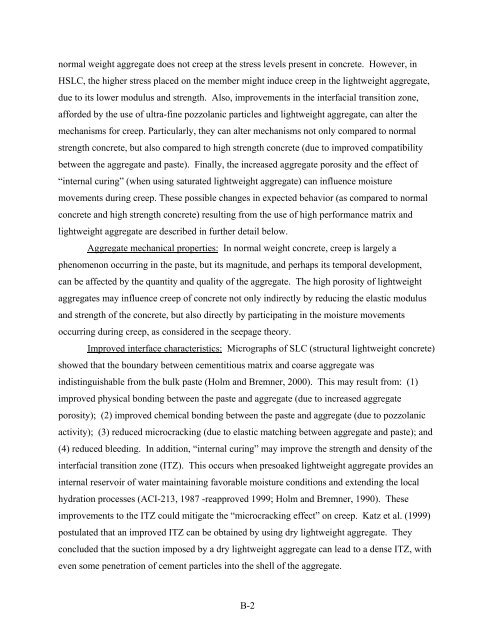Lightweight Concrete for High Strength - Expanded Shale & Clay
Lightweight Concrete for High Strength - Expanded Shale & Clay
Lightweight Concrete for High Strength - Expanded Shale & Clay
You also want an ePaper? Increase the reach of your titles
YUMPU automatically turns print PDFs into web optimized ePapers that Google loves.
normal weight aggregate does not creep at the stress levels present in concrete. However, in<br />
HSLC, the higher stress placed on the member might induce creep in the lightweight aggregate,<br />
due to its lower modulus and strength. Also, improvements in the interfacial transition zone,<br />
af<strong>for</strong>ded by the use of ultra-fine pozzolanic particles and lightweight aggregate, can alter the<br />
mechanisms <strong>for</strong> creep. Particularly, they can alter mechanisms not only compared to normal<br />
strength concrete, but also compared to high strength concrete (due to improved compatibility<br />
between the aggregate and paste). Finally, the increased aggregate porosity and the effect of<br />
“internal curing” (when using saturated lightweight aggregate) can influence moisture<br />
movements during creep. These possible changes in expected behavior (as compared to normal<br />
concrete and high strength concrete) resulting from the use of high per<strong>for</strong>mance matrix and<br />
lightweight aggregate are described in further detail below.<br />
Aggregate mechanical properties: In normal weight concrete, creep is largely a<br />
phenomenon occurring in the paste, but its magnitude, and perhaps its temporal development,<br />
can be affected by the quantity and quality of the aggregate. The high porosity of lightweight<br />
aggregates may influence creep of concrete not only indirectly by reducing the elastic modulus<br />
and strength of the concrete, but also directly by participating in the moisture movements<br />
occurring during creep, as considered in the seepage theory.<br />
Improved interface characteristics: Micrographs of SLC (structural lightweight concrete)<br />
showed that the boundary between cementitious matrix and coarse aggregate was<br />
indistinguishable from the bulk paste (Holm and Bremner, 2000). This may result from: (1)<br />
improved physical bonding between the paste and aggregate (due to increased aggregate<br />
porosity); (2) improved chemical bonding between the paste and aggregate (due to pozzolanic<br />
activity); (3) reduced microcracking (due to elastic matching between aggregate and paste); and<br />
(4) reduced bleeding. In addition, “internal curing” may improve the strength and density of the<br />
interfacial transition zone (ITZ). This occurs when presoaked lightweight aggregate provides an<br />
internal reservoir of water maintaining favorable moisture conditions and extending the local<br />
hydration processes (ACI-213, 1987 -reapproved 1999; Holm and Bremner, 1990). These<br />
improvements to the ITZ could mitigate the “microcracking effect” on creep. Katz et al. (1999)<br />
postulated that an improved ITZ can be obtained by using dry lightweight aggregate. They<br />
concluded that the suction imposed by a dry lightweight aggregate can lead to a dense ITZ, with<br />
even some penetration of cement particles into the shell of the aggregate.<br />
B-2















